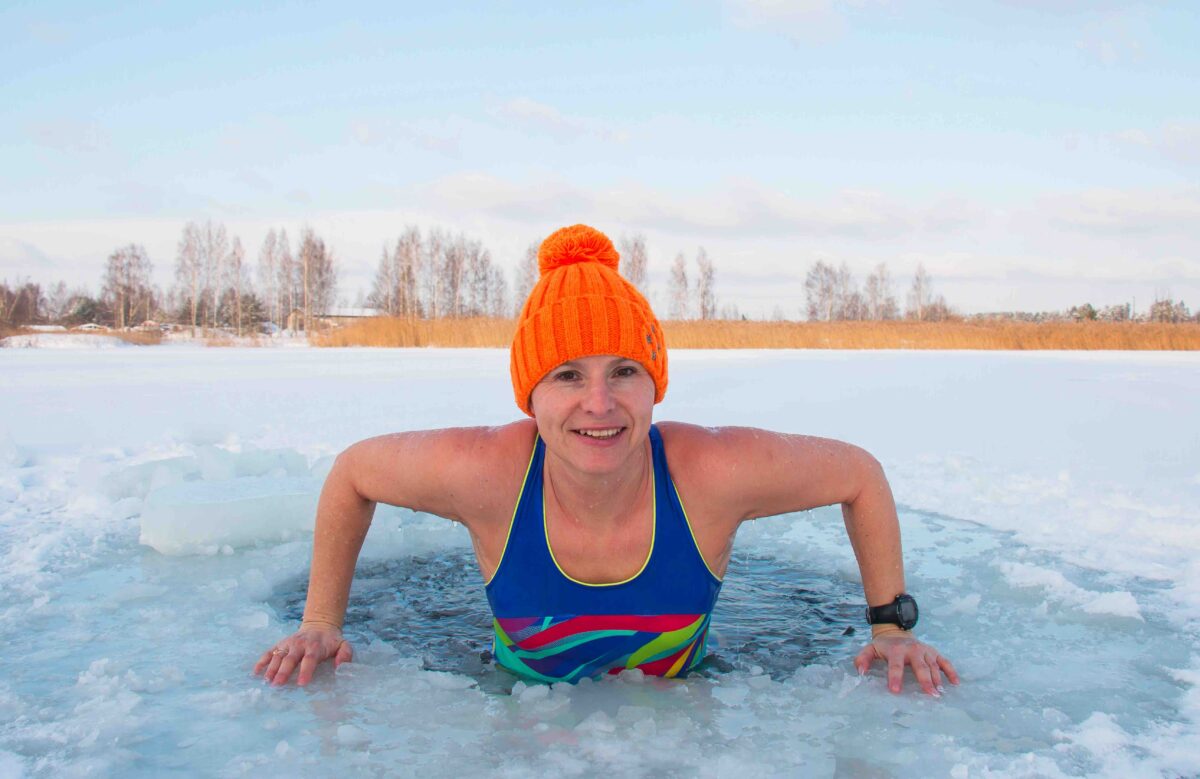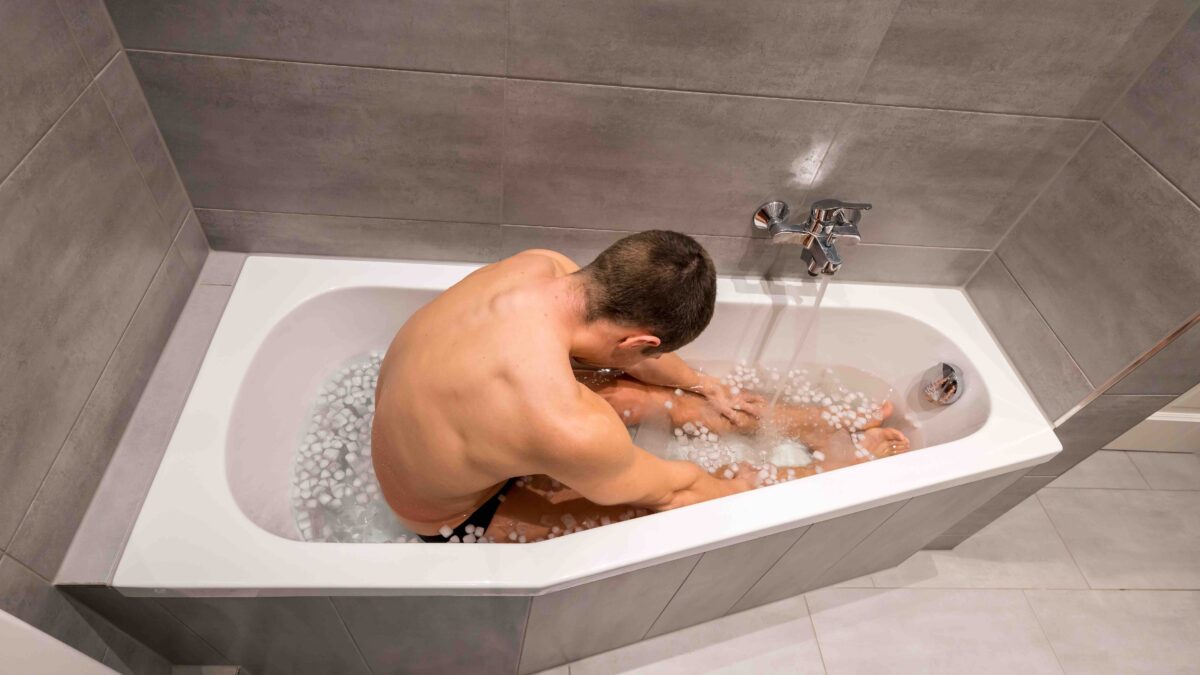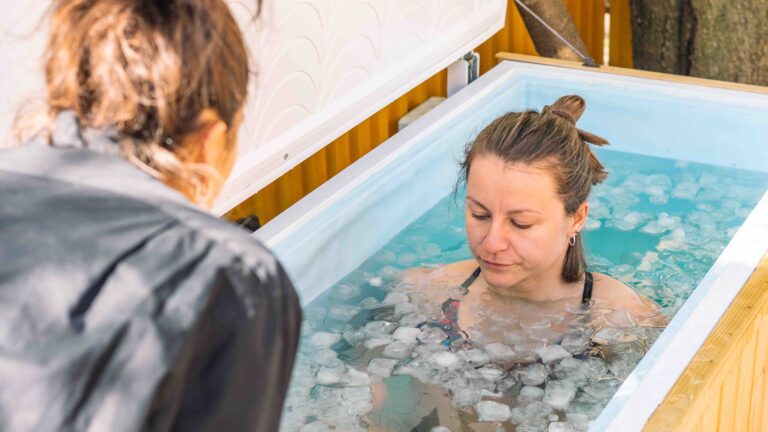Ah, the ice bath. Just hearing those two words together can send a chill through your body – literally! An increasingly popular recovery method among athletes, an ice bath is exactly what it sounds like: sitting in a tub of cold water and ice. But why would anyone willingly subject themselves to such frigid temperatures? Here we’ll explore the science behind why taking an icy plunge may actually be beneficial for your health and wellbeing.
The concept of submerging oneself into freezing water has been around since ancient times; Hippocrates himself recommended people take baths in cold spring waters to relieve ailments such as soreness or inflammation. Fast forward to modern day, and you can find professional athletes from all sports boasting about how regular ice baths have helped improve their performance on the field or court. Whether you’re competing at a high level or simply looking for relief after a hard workout, here’s why you might want to consider adding this age-old practice back into your routine.
For starters, studies suggest that exposing yourself to cooler temperatures can help reduce muscle pain, swelling and fatigue by constricting blood vessels and reducing inflammation caused by intense physical activity. Not only that – research also suggests that immersing yourself regularly in cold water can help boost immunity against illnesses, lower stress levels and even increase alertness! So despite its less than inviting reputation, there are plenty of good reasons why hopping into an ice bath could be just what the doctor ordered.
What is an ice bath?
An ice bath is a therapeutic technique that involves submerging your body in cold water for a period of time. It’s not the same as taking a dip in an icy lake or ocean; instead, it involves filling up a tub with very cold water and soaking in it for 10 to 15 minutes. While this may sound like a painful experience, there are actually some great benefits associated with taking regular ice baths.
The first benefit of an ice bath is improved performance during exercise. Research shows that taking an ice bath after intense physical activity helps reduce inflammation and soreness while also speeding up muscle recovery time. Ice baths can also help athletes increase their endurance by increasing blood flow throughout the body and helping muscles stay warm during strenuous activities.
Another benefit of using an ice bath is stress relief. By exposing yourself to extreme temperatures, you’re able to reset your system and trigger relaxation responses from your brain. In addition to reducing stress levels, research has shown that taking regular ice baths can also improve sleep quality, boost moods and even aid in weight loss efforts by stimulating metabolism and burning calories more efficiently.
Overall, there are many advantages to be gained through the use of an ice bath beyond simply cooling off after a rigorous workout or athletic competition. With its capacity to reduce inflammation, speed up recovery times, relieve stress and improve overall wellness, it’s no surprise why so many people have incorporated this practice into their daily routine.
Benefits of an ice bath
So, what are the benefits of taking an ice bath? An ice bath can help reduce pain and inflammation in your muscles. Not only that, but it also encourages blood flow to the affected area, which helps promote healing. Plus, it’s great for mental health too!
The cold temperature of a regular ice bath helps keep you alert during training sessions or after physical activity. It can also be beneficial to those with high-intensity exercise routines because it helps decrease fatigue levels. Furthermore, immersion in cold water can increase tissue metabolism, allowing for better results from any type of workout routine.
Finally, there is evidence that suggests an ice bath could have long term effects on fitness performance. Research has shown that athletes who take regular cold baths may find their body recovers quicker between workouts and experiences less post-exercise soreness over time. This means they can train for longer periods at higher intensity without needing rest days as often – leading to improved overall fitness levels over time.

How to prepare for an ice bath
Preparing for an ice bath can be a daunting task, especially if you’re new to the practice. But with some simple steps and planning, you’ll find that taking this plunge is worth it in the end. Here’s how to do it:
First of all, make sure you have enough cold water to submerge yourself up to your chest or neck depending on your comfort level. Fill the tub or container – like a large bucket – with several bags of ice cubes until the water reaches a temperature between 50-60 degrees Fahrenheit. If you don’t have access to any containers big enough, consider using two smaller ones instead.
Next, equip yourself with everything you’ll need while immersed in the water. That means bringing towels, blankets and clothing items such as hats and gloves so that when we come out from our icy dip we can stay warm afterwards: • Towels – To dry off afterwards • Blankets – To keep us warm after getting out of the ice bath • Hats/Gloves– To protect against extreme temperatures
Finally, set a timer before getting into the bath; most experts recommend staying in for 10 minutes at first but those experienced with ice baths usually extend their time in one session up to 15-20 minutes. Make sure to take deep breaths during your time under the cold water because this will help relax your muscles and reduce tension throughout your body!
How do ice baths help athlets
The use of ice baths for athletes has become increasingly popular in recent years. This is due to the multitude of benefits that this type of therapy can provide, from helping with muscle recovery and pain relief to promoting better sleep quality. But how exactly does an ice bath benefit athletes?
One way ice baths are beneficial for athletes is by reducing inflammation after intense workouts or competitions. Cold temperatures can help reduce swelling and decrease any soreness caused by exercise, allowing the athlete to recover faster without having to take days off from training or competing. Additionally, taking a cold shower immediately following a workout helps muscles contract more quickly which reduces fatigue while also increasing power output during subsequent performances.
Regular exposure to cold water may even have long-term health benefits such as improved immune system function, increased metabolic rate, and a reduced risk of cardiovascular disease. Furthermore, it’s been shown that people who regularly perform cryotherapy (via short duration whole body exposure to cold) report lower levels of stress than those who don’t participate in the practice – another potential advantage for competitive athletes!
So whether you’re looking to speed up your recovery time after heavy lifts or simply trying to stay healthy throughout strenuous training sessions, there’s no denying the positive impact that an ice bath can have on any athlete’s performance and overall wellbeing.

Risks of an ice bath
Taking an ice bath can be a great way to reduce muscle soreness and inflammation, but it does come with some risks. Understanding the potential dangers of this practice is important for anyone considering taking an ice bath.
The most common risks associated with ice baths include:
- Hypothermia – when body temperature drops too low from exposure to cold temperatures.
- Nerve Damage – prolonged exposure to extreme cold conditions can affect nerve endings, leading to numbness or tingling in extremities.
- Worsening Joint Pain – although being in cold water may temporarily reduce pain levels due to numbing effects, repeated immersions may cause joint swelling and increased discomfort.
- Skin Irritation – over-exposure to icy water can lead to dry skin, as well as redness, itching and burning sensations on the affected area.
It’s important for athletes (or anyone else who wants to try an ice bath) to understand these risks before jumping into icy waters. To avoid any health complications, it’s best to start slow by only spending short periods of time in cool water and gradually increasing duration as you become more accustomed to the sensation. Additionally, consult your doctor if you have questions about whether an ice bath would be beneficial or safe for you specifically.
How long to stay in an ice bath
Staying in an ice bath for too long can be dangerous, so it’s important to know the recommended time period. Generally speaking, you should start by staying in an ice bath for no more than 10 minutes and gradually increase your duration over several sessions.
It is also important to remember that submerging yourself completely into cold water increases the risk of hypothermia — a condition where your body temperature drops below 35°C (95°F). To prevent this from happening, make sure the temperature outside of your bath isn’t too low either. Additionally, check with your doctor before taking any kind of extreme plunge like this one as some people are at greater risks due to medical conditions.
When done safely and correctly, however, there are plenty of potential benefits associated with taking an ice bath such as decreasing inflammation and soreness after exercise or improving endurance performance. So if you’re looking to reap these rewards while avoiding potential dangers, make sure you follow proper guidelines when deciding on how long to stay in the ice bath!
How to take an ice bath
Taking an ice bath can be intimidating, especially if it’s your first time. But there are some simple tips that can help make the experience a bit more comfortable and enjoyable. Here are nine of them to keep in mind when preparing for an icy plunge!
- Take your time getting into the water. You don’t want to shock your body by jumping straight in – ease yourself in gradually instead.
- Start with cold water rather than freezing temperatures right away; you can always add a few more cubes of ice as needed.
- Use warm towels or blankets afterwards to avoid hypothermia.
- Limit each session to no longer than 10 minutes so you don’t become too uncomfortable or risk overstressing your nervous system.
Stay hydrated before and after taking an ice bath – dehydration can cause dizziness and other unpleasant side effects during and after the process. Sixthly, never take an ice bath alone – have someone nearby who knows what they’re doing just in case something goes wrong. Seventhly, wear appropriate clothing such as wetsuits or swimsuits – these will give you some insulation from direct contact with the cold temperature of the water.
Listen to music while taking an ice bath to help distract yourself from its intensity and provide a calming environment.
In short, following these tips can help ensure that your next ice bathing sessions go smoothly and safely – allowing you to reap all the potential benefits associated with this type of therapy without any unwanted surprises!
Ice bath alternatives
Taking an ice bath can be a great way to reduce inflammation, recover from muscle soreness and improve performance. However, it isn’t for everyone — some people may find the sensation of icy water too uncomfortable or even painful. So what are the alternatives?
For those who don’t enjoy the feeling of cold water but still want to take advantage of its benefits, there are several options available. Cryotherapy is one option which involves standing in a chamber filled with extremely cold air instead of water. This method has been found to have similar effects as an ice bath without being quite as intense. Additionally, you could opt for contrast therapy, which includes alternating between hot and cold baths or showers throughout your session. This helps stimulate blood circulation while providing relief from any aches and pains that come along with exercise.
No matter which form of recovery you choose, it’s important to make sure that it fits into your lifestyle and schedule so that you’re able to get all the benefits without sacrificing time or energy elsewhere. Whether you decide on an ice bath or another alternative such as cryotherapy or contrast therapy, taking steps toward recovery after physical activity will help keep your body healthy and ready for future workouts.
What to do after an ice bath
After taking an ice bath, you’ll want to make sure that your body is properly taken care of. There are a few steps you can take to ensure your continued health and wellbeing:
- Rehydrate – After the ice bath, it’s important to replenish the fluids lost during the cooling process. Drinking water or electrolyte-rich sports drinks can help restore hydration levels.
- Change into warm clothes – You’ll want to put on some warmer clothing after exiting the cold environment of the ice bath to prevent any further heat loss. A pair of sweatpants and long-sleeved shirt should do just fine.
- Do light stretches – To increase circulation and reduce soreness, do some gentle stretching exercises like arm circles or leg swings for 5–10 minutes. Doing this will help loosen up tight muscles and keep them supple.
- Take a warm shower – Taking a hot shower afterwards helps bring back the warmth your body needs as well as helping with relaxation. This also washes away any residual salt from perspiration which may have been left behind in the tub during the session.
To maximize post-ice bath recovery time, it’s best to follow these guidelines while still maintaining proper nutrition habits such as eating plenty of protein rich foods, healthy fats & carbohydrates and drinking enough water throughout the day. Doing so can help speed up the healing process and get you back in fighting shape faster!

How often to take an ice bath
Taking an ice bath may seem like a daunting task, but it can do wonders for your health. It’s important to understand how often you should be doing them in order to get the most benefit from this practice.
First, let’s look at what exactly an ice bath is: it’s simply sitting or standing in water that has been cooled with significantly more than one pound of ice per gallon. This type of cold therapy helps reduce inflammation and muscle soreness while improving circulation and tissue repair.
So, when it comes to taking an ice bath, here are some tips on frequency:
- Take an ice bath no more than twice a week – any more than that could actually cause too much stress on the body and lead to injury.
- After intense physical activity, wait until 48 hours have passed before taking another ice bath so your body has enough time to recover properly.
- If you find yourself having trouble sleeping after taking one, consider cutting back on the number of times you take one each week.
Ultimately, everyone is different and will need to figure out the best schedule for themselves based on their individual needs and lifestyle factors. An effective way to start is by listening to your body – if it feels tired or overworked then give yourself some extra rest instead of opting for an icy dip.
Conclusion
To conclude, taking an ice bath can be beneficial for many people. It’s important to make sure you are taking the proper precautions when considering this type of therapy. If you have any underlying medical conditions, it is best to consult with your doctor before trying a cold water immersion. We must also remember that pregnant women should not take ice baths as they may cause harm to both mother and baby.
Overall, if done safely and in moderation, ice baths can help reduce muscle soreness and fatigue while improving athletic performance. They can also boost circulation, decrease inflammation, reduce stress levels and improve sleep quality. Everyone’s body responds differently so it’s important to start slowly and experiment with different temperatures until you find what works best for you. With the right approach, taking an ice bath could become a regular part of your health routine!





